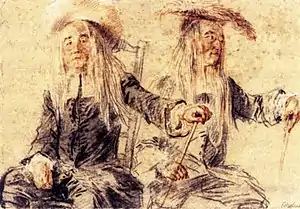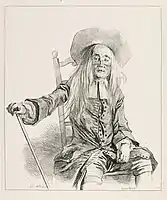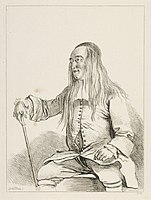Two Studies of an Actor (Watteau)
Two Studies of an Actor is the name given to a sheet of drawings by the French Rococo artist Antoine Watteau in the trois crayons technique. Once in the collection of Watteau's friend Jean de Jullienne, the sheet was owned by private collectors in Germany by 1874, the year when it was acquired by the Kupferstichkabinett, Berlin, where it remains. The sheet shows two half-leng half-length portraits of an old man in different turns, variously but not definitively identified as the Catholic priest Pierre-Maurice Haranger, a close friend of Watteau, or the Comédie-Française player Pierre Le Noir, dit La Thorillière.
| Two Studies of an Actor | |
|---|---|
 | |
| Artist | Antoine Watteau |
| Year | ca. 1715–1721 See § Provenance and dating |
| Catalogue | PM 914; RP 653 |
| Medium | Sanguine, black, and white chalks on brownish paper, laid down |
| Subject | presumed to be either Pierre-Maurice Haranger or Pierre Le Noir de la Thorillière See § Identity of the subject |
| Dimensions | 26 cm × 37.2 cm (10 in × 14.6 in) |
| Location | Kupferstichkabinett, Berlin |
| Accession | KdZ 2319 |
Provenance and dating
In the 18th century, the sheet belonged to Watteau's friend and patron Jean de Jullienne; it was presumed that the sheet corresponds with a description of no. 737 in the sale held after Jullienne's death in Spring 1767, described as "Deux hommes en habit de paysan; ils sont assis, la main gauche de chacun est posée sur une canne en béquille." During the 19th century, it was in various private collectors, until it has been acquired by the Kupferstichkabinett, Berlin.[1][2]
Related prints
In the 1720s, François Boucher has adapted the sheet into two separate etchings, published as plates 69 and 198 in the Figures de différents caractères; while engraving the figure at right, Boucher replaced the hat with a skullcap.[2] Boucher's etching of the said figure has been later reproduced by Claude Du Bosc, captioned La Tourilere comédien.[3]
Identity of the sitter
In his article published in Gazette des Beaux-Arts in 1896, the playwright and poet Gaston Schéfer was the first to try and identify the sitter of the drawings, available to him through Boucher's etchings. In a copy of the Figures de différents caractères held by the Bibliothèque de l'Arsenal, Schéfer discovered that the impression of folio 198 has an inscription by eighteenth-century hand, believed to be that of Pierre-Jean Mariette, saying "Portrait de l'abbé Larancher (struck-through) Haranger Chanoine de Saint-Germain-l'Auxerrois, ami de Watteau." From the inscription, Schéfer suggested that the drawings showed portraits of the Abbé Pierre-Maurice Haranger (ca. 1655–1735), canon at the Saint-Germain l'Auxerrois who was one of Watteau's closest friends.[note 1] It has been stated that to Watteau, it wasn't controversial to depict a Catholic priest wearing an unusual attire, for it wasn't so to the Church; Schéfer provides a similar example of Charles-Nicolas Cochin who produced a drawing of his priest friend, the Abbé François-Emmanuel Pommyer, wearing a peasant dress. It has also been presumed that a study of Haranger, similar to the Berlin sheet, was used in another composition by Watteau, The Coquettes.[lower-alpha 1][7]:345
Gallery
- Related prints
 François Boucher, Vieillard assis sur une chaise, coiffé d'un grand chapeau, 1726, etching, folio 69 in Figures de differents caracteres, Louvre, Paris
François Boucher, Vieillard assis sur une chaise, coiffé d'un grand chapeau, 1726, etching, folio 69 in Figures de differents caracteres, Louvre, Paris François Boucher, Vieillard assis, coiffé d'une calotte, 1726, etching, folio 198 in Figures de differents caracteres, Louvre, Paris
François Boucher, Vieillard assis, coiffé d'une calotte, 1726, etching, folio 198 in Figures de differents caracteres, Louvre, Paris Claude Du Bosc after François Boucher, La Tourilere comédien, 1730s, etching, British Museum, London
Claude Du Bosc after François Boucher, La Tourilere comédien, 1730s, etching, British Museum, London
Exhibition history
| Year | Title | Location | Cat. no. | ||||||
|---|---|---|---|---|---|---|---|---|---|
| 1950 | Le dessin français de Fouquet à Cezanne | Musée de l'Orangerie, Paris | 60 | ||||||
| 1984–1985 | Watteau 1684–1721 | National Gallery of Art, Washington, D.C.; Galeries nationales du Grand Palais, Paris; Charlottenburg Palace, Berlin | D. 72 | ||||||
| 2011 | Watteau: The Drawings | Royal Academy of Arts, London | 86 | ||||||
| General references: Grasselli, Rosenberg & Parmantier 1984, p. 142. | |||||||||
Quotes
- "L'étude n" 198, gravée par Boucher, nous représente le barbon de la Comédie italienne, posé de trois quarts, assis sur une chaise. Il est coiffé d'une perruque à cheveux longs. Une autre étude (n° 69), également gravée par Boucher, le figure de face, un large chapeau sur la tète. Sous l'étude n" 198, Mariette a écrit : « Portrait de l'abbé Larancher. » C'est ainsi qu'il est nommé également dans le Mercure. Mais il a effacé le nom et l'a corrigé par « Aranger », selon l'orthographe de l'Abecedario. Un prêtre sous un tel habit, voilà qui paraît surprenant; mais au XVIIIe siècle l'Eglise avait sa bonhomie. Watteau ne croyait pas plus faire œuvre de scandale en déguisant l'abbé Haranger sous la perruque de Géronte que Cochin en dessinant l'abbé Pommyer sous l'habit du Paysan de Gandelu. D'ailleurs, l'abbé Haranger avait une si bonne physionomie de théâtre que l'on rencontre son portrait sous un autre nom : « La Thourilère, La Thorillière. » Peut-être même une autre étude de l'abbé Haranger a-t-elle servi au vieillard du tableau des Coquettes. Mais ici la ressemblance n'est pas assez directe pour qu'on puisse rien affirmer."[6]
Notes
- Since 1681, Abbé Pierre-Maurice Haranger (ca. 1655–May 10, 1735) served as sub-deacon in the diocese of Paris and canon at the Saint-Germain l'Auxerrois, located close to the Louvre Palace, the seat of the Royal Academy of Painting and Sculpture. The inventory taken after Haranger's death, discovered and published by Jeannine Baticle in the mid-1980s,[4] shows his taste of furniture and paintings, as well as his relationship with Watteau, for whom Haranger arranged the final home at Nogent-sur-Marne; it also questioned the generally accepted theory, based on Edme-François Gersaint's account, that Watteau had divided his drawings among Haranger, Jean Jullienne, Gersaint, and royal councilor Nicolas Henin. Haranger's collection, that estimated about thousand drawings by Watteau, has been dispersed upon his death.[5]
References
- Goncourt 1875, p. 253: "Le dessin aux trois crayons de cette étude avec quelques changements et deux fois répété, le dessin provenant des collections de Vos, Blockhuisen, est actuellement en possession de M. Suermondt. C'est incontestablement le n° 787 de la vente Julienne : « Deux hommes en habit de paysan; ils sont assis, la main gauche de chacun est posée sur une canne en béquille. » Ce double dessin aux trois crayons avec deux autres études de têtes était vendu 82 1. 2 s."
- Grasselli, Rosenberg & Parmantier 1984, p. 142.
- Goncourt 1875, p. 72, cat. no. 74; Dacier & Vuaflart 1922, p. 141, cited in Grasselli, Rosenberg & Parmantier 1984, p. 478.
- "Inventaire après décès du chanoine Haranger, 17 mai 1735". Revue de l'Art (in French) (69): 62–68. 1985. doi:10.3406/rvart.1985.347525 – via Persee.fr.
- Parmantier-Lallement, Nicole (1996). "Haranger, Pierre-Maurice, Abbé". In Turner, Jane (ed.). The Dictionary of Art. 14. New York: Grove's Dictionaries. p. 162. ISBN 1-884446-00-0 – via the Internet Archive.
- Schéfer 1896, p. 185.
- Fourcaud, Louis de (November 1901). "Antoine Watteau. VI. — L'invention sentimentale, l'effort technique et les pratiques de composition et d'exécution de Watteau (Suite)". La Revue de l'art ancien et moderne. 10 (56): 337–349 – via the Internet Archive.
[…] qu'au vieil homme en cheveux plats de Coquettes gui pour voir... il semble bien que ce digne chanoine de Saint-Germain-l'Auxerrois ait prêté son visage, […]
Further reading
- Baticle, Jeannine (1985). "Le chanoine Haranger, ami de Watteau". Revue de l'Art (in French) (69): 55–61. doi:10.3406/rvart.1985.347524 – via Persee.fr.
- Dacier, Émile (December 10, 1921). "Autour de Watteau (II)". Le Bulletin de l'art ancien et moderne (680): 213–216 – via the Internet Archive.CS1 maint: ref=harv (link)
- Dacier, Émile; Vuaflart, Albert (1922). Jean de Julienne et les graveurs de Watteau au XVIII-e siècle. III. Catalogue (in French). Paris: M. Rousseau. p. 141. OCLC 1039156495.
- Gillet, Louis (1921). Watteau: un grand maître du XVIIIe siècle. Paris: Plon. p. 90. OCLC 1102350703 – via the Internet Archive.
- Glorieux, Guillaume (2002). À l'enseigne de Gersaint: Edme-François Gersaint, marchand d'art sur le pont Notre-Dame (1694-1750). Seysell: Editions Champ Vallon. p. 431. ISBN 2-87673-344-7. OCLC 401692541 – via Google Books.
- Goncourt, Edmond de (1875). Catalogue raisonné de l'oeuvre peint, dessiné et gravé d'Antoine Watteau. Paris: Rapilly. OCLC 1041772738 – via the Internet Archive.
- Goncourt, Edmond de; Goncourt, Jules de (1880) [1860]. L'art du dix-huitième siècle. 1er fasc.: Watteau (3rd ed.). Paris: A. Quantin. p. 55. OCLC 1157138267 – via the Internet Archive.
- Grasselli, Margaret Morgan; Rosenberg, Pierre; Parmantier, Nicole; et al. (1984). Watteau, 1684-1721 (PDF) (exhibition catalogue). Washington: National Gallery of Art. ISBN 0-89468-074-9. OCLC 557740787 – via the National Gallery of Art archive.
- Herold, Jacques; Vuaflart, Albert (1929). Jean de Julienne et les graveurs de Watteau au XVIII-e siècle. I. Notices et documents biographiques (in French). Paris: M. Rousseau. p. 117. OCLC 1039157338.
- Hildebrandt, Edmund (1923). Antoine Watteau (in German). Berlin: Propyläen-Verlag. pp. 73, 132; pl. 25. OCLC 1039987046 – via the Internet Archive.
- Josz, Virgile (1904). Antoine Watteau (in French). Paris: H. Piazza et cie. p. 181. OCLC 963518006 – via the Internet Archive.CS1 maint: ref=harv (link)
- Lauterbach, Iris (2008). Antoine Watteau, 1684-1721. Back to Visual Basics. Köln: Taschen. p. 69. ISBN 978-3-8228-5318-4. OCLC 1164836547 – via the Internet Archive.
- Parker, Karl T. & Mathey, Jacques (1957–1958). Antoine Watteau: catalogue complet de son oeuvre dessiné. Paris: F. de Nobèle. vol. 2, p. 378, cat. no. 914. OCLC 2039948.
- Parker, Karl T. (1970) [1931]. The Drawings of Antoine Watteau. New York: Hacker Art Books. pp. 21, 47. ISBN 0-87817-050-2. OCLC 680613312 – via the Internet Archive.
- Pilon, Edmond (1912). Watteau et son école (in French). Bruxelles etc.: G. van Oest & cie. p. 40. OCLC 1158281157 – via the Internet Archive.
- Roland Michel, Marianne (1984). Watteau (in French). Paris: Flammarion. pp. 55–56, 173, 253; pl. 30, 270, 271. ISBN 9782080120205. OCLC 417153549.
- Rosenberg, Pierre & Prat, Louis-Antoine (1996). Antoine Watteau: catalogue raisonné des dessins (in French). Paris: Gallimard-Electa. vol. 2, p. 1116, cat. no. 653. ISBN 2070150437. OCLC 463981169.
- Rosenberg, Pierre; Prat, Louis-Antoine & Eidelberg, Martin (2011). Watteau: The Drawings (exhibition catalogue). London: Royal Academy of Arts. cat. no. 86. ISBN 9781905711703. OCLC 740683643.CS1 maint: ref=harv (link)
- Schéfer, Gaston (September 1896). "Les Portraits dans l'oeuvre de Watteau". Gazette des Beaux-Arts (in French) (471): 177–189 – via the Internet Archive.
- Toney, Anthony, ed. (1963). 150 Masterpieces of Drawing. New York: Dover. p. XIV, pl. 118. OCLC 1145793764 – via the Internet Archive.
- Vetter, Andreas W. (2005). …von sanften Tönen bezaubert!: Antoine Watteau – «Venezianische Feste» (exhibition catalogue) (in German). Braunschweig: Herzog Anton-Ulrich Museum. ISBN 3-922279-61-9.